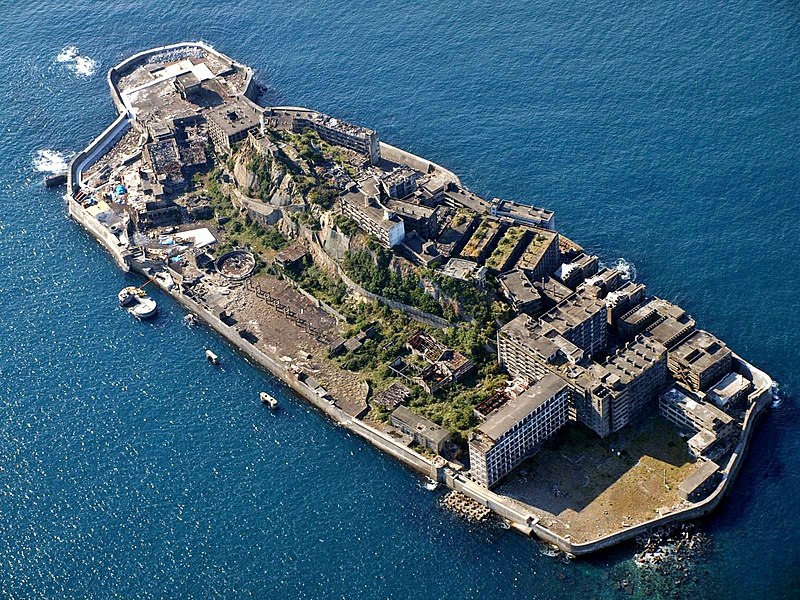Hashima is an islet of 6.3 hectares lying off the coast of Nagasaki prefecture. From afar, its buildings and high walls, designed to protect it from typhoons, make it look like a fortress, or rather like a battleship, hence its Japanese nickname 'Gunkanjima' (軍艦島), or 'Battleship Island'.
During the Meiji Era (1868-1912) Hashima played an important role in Japan's rapid industrialisation. Coal, the fuel of the first industrial revolution, was abundant in the region. In 1890 Hashima was bought by Mitsubishi, which set up coal-mining facilities. The company transformed the islet into a major industrial site and a pioneering residential area, a model for Japan's industrial and urban development.
Mitsubishi sank vertical shafts of about 200 metres, erected massive walls and carried out land reclamation projects in order to obtain new land for the construction of factories. Due to the demand for labour, workers began to flock to Hashima. The population grew steadily, and in 1916 Mitsubishi built a nine-storey reinforced concrete apartment block - the largest in Japan at the time. Many more residential buildings were constructed over the following decades.

|
|
Hashima (source: "Battle-Ship Island Nagasaki Japan" by Flickr user: kntrty http://www.flickr.com/photos/kntrty/) |
The new urban landscape reflected the country's hierarchical system; while the manager lived in the only private house on top of the island, the workers were housed in tiny flats of 10 square metres with shared bathrooms. By 1959 the residential district had a population density of 1,391 people per hectare, the highest ever recorded (John Pendlebury / Erdem Erten et al.: Alternative Visions of Post-War Reconstruction, p. 92). In its heyday, 5,259 people lived on Hashima.
The island-city had everything its inhabitants needed: an elementary school, a playground, a cinema, a hospital, a hairdresser's, bars, restaurants, and even a Buddhist temple and a brothel. Space was so scarce that the kindergarten and the swimming pool were built on a rooftop. Yet the working conditions were good. In the 1950s, Hashima had a higher living standard than elsewhere in Japan. Refrigerators, washing machines and a TV sets became common household items earlier than in the rest of the country.
In the late 1960s began Hashima's rapid decline - as fast and abrupt as had been its astounding rise. Oil replaced coal as the world's fossil fuel. The demand for coal sank and Hashima's industrial facilities soon became obsolete and unprofitable. In 1974 Mitsubishi announced that the plant would be closed down. A few months later the island was deserted. Thus began the inexorable decline of a city which had once been filled with life. Its apartment blocks, shops and factories were left to decay, battered by the sea winds and the typhoons.
Hashima is only one of 23 industrial facilities from the Meiji Era that the Japanese government wants to have listed as UNESCO World Heritage sites. According to Tokyo, their historic value lies in the fact that they illustrate Japan's path of industrialisation, which occurred through the importation of Western technology and methods, but without foreign direct investment.
On May 4, the Japanese government announced that a UNESCO advisory panel had recommended Japan’s “Sites of the Meiji Industrial Revolution” for inclusion in the prestigious list. The final decision will be made on June 28-July 8, when the World Heritage Committee convenes in the German city of Bonn.
The 23 sites include abandoned and decrepit facilities such as Hashima, the Hagi reverberatory furnace in Yamaguchi Prefecture, the former head office of Yawata Steel Works in Kita-Kyushu, and the former Manda pit at the Miike coal mine in Arao, Kumamoto Prefecture. Other sites, like the Miike port in Omuta, Fukuoka Prefecture, or the Nagasaki shipyard facilities, are still in operation.
Yet while the 23 sites are unquestionably important for the history of Japan's modernisation and its rise to the status of an industrial nation, they also have a darker and more controversial side. During Japan's imperialist era (1895-1945), hundreds of Koreans and Chinese labourers were forced to work at Japanese industrial facilities, including Hashima and other locations that Tokyo now seeks to add to the list of the UNESCO World Heritage sites. This has enraged the governments of the People's Republic of China (PRC) and of South Korea.
According to the South Korean government, during the Second World War around 4,700 Koreans were forced to work at the Nagasaki shipyard to build warships, while 800 people worked in Hashima. The Japanese also used Chinese prisoners of war as slave labourers. "The common stories I heard from Korean and Chinese laborers was that they are enormously hungry," said Hideo Kaji, who was born on Hashima in 1932, in a CNN interview. "The meals were miserable and when they could not go to work they were tortured, punched and kicked."
At a press conference on May 14, Hua Chunying, the Foreign Ministry spokesperson of the PRC, slammed Japan's choice of the 23 sites. "The world cultural heritage application should live up to the principle and spirit of promoting peace," she stated. "Many of the 23 Japanese industrial sites witnessed the use of forced labor from China, the Korean Peninsula and other Asian countries during the Second World War. The forced recruitment and enslavement of labor was a heinous crime committed by Japanese militarism during its aggression and colonial rule of other countries."
According to Japanese media reports, Tokyo plans to send eight envoys of Prime Minister Shinzo Abe to 15 of the 21 countries who are members of the World Heritage Committee. Japan and South Korea will hold a meeting to discuss the issue on May 22.
Comments
Post a comment